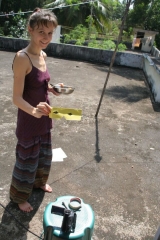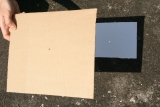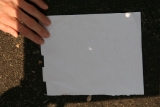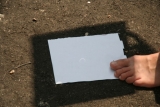Annular Solar Eclipse in Varkala, India
January 15, 2010
Topics: India
On 15th of January 2010 we had a chance to witness the annular solar eclipse which started in Central Africa, passed through the Indian Ocean and Maldives islands, touched the South tip of India, and ended somewhere in China. Sources say it was the longest annular solar eclipse in this millennium.
For non English native speakers – “annular” means that the Moon is smaller than the Sun, hence during the eclipse the Sun can be visible as a ring, or annulus, which surrounds the Moon. In the short video we have made you will be able to see the ring. The Moon covered about 84% of the surface of the Sun. A very nice animation of the view of the whole Solar Eclipse near our area can be found on the eclipse.org.uk website.

Katja enjoying the experiment holding the selfmade glasses, which we got from the people in our community.
The eclipse started around 11:05am, but at that point it was not exciting yet. Around this time our doorbell rang. Outside were standing three young men introducing themselves as representatives of the local community. They informed about the Eclipse and gave us selfmade glasses for watching the Sun (pieces of silver plastic stapled between a yellow sheet of paper). Already for several days we were thinking of what would be the best way to watch the Eclipse and then these glasses appeared, being everything we needed! However, we tried the projection method – we pinched a hole in a piece of carton and projected the Sun on a white paper. And it worked!
The full overlap of the Moon and the Sun happened around 1:10pm. The coverage of 84% means that it is not possible to look at the Sun with the naked eye. The peak of the Eclipse lasted for about 2-3 minutes (more towards Sri Lanka it was supposed to last for up to 6-8 minutes) and the Moon continued its trajectory by slowly uncovering the Sun. We got less sunlight in the air. It was dim, but bright enough to see everything clearly. Became fresh and breezy. Katja smiled: “This is the weather which would be perfect for us!”.
The Eclipse ended around 3:05pm, but for us it wasn’t exciting anymore to continue watching the Moon partly covering the Sun.







Comments
Leave a comment